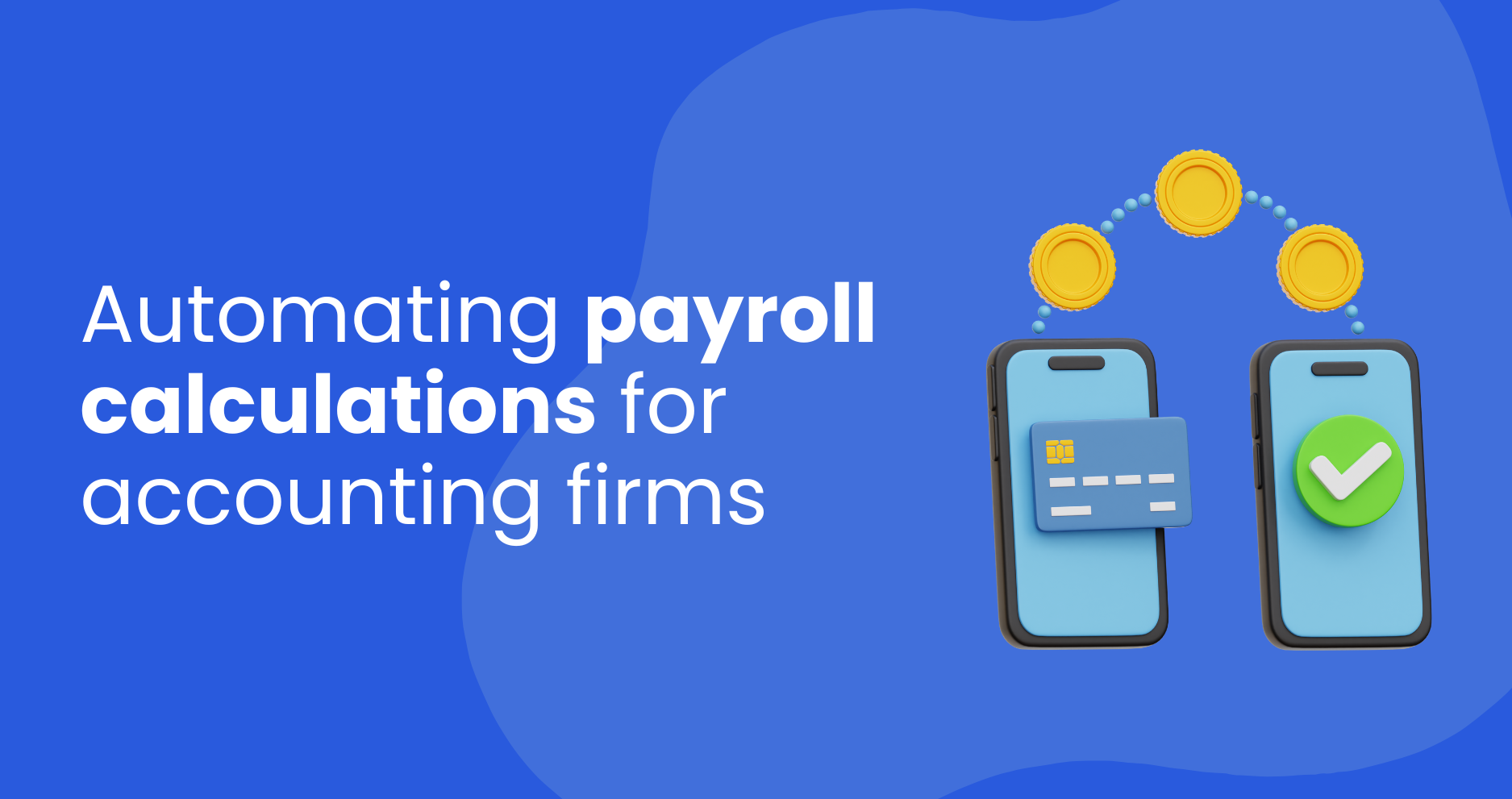Handling payroll for different subsidiaries, clients, employee categories, firms necessitates navigating various pay structures, tax regulations, and compliance requirements. AccountsGPT can ease associated challenges.

Payroll processing is a critical yet complex task for firms managing multiple payroll systems. Whether handling payroll for different subsidiaries, clients, or employee categories, firms must navigate various pay structures, tax regulations, and compliance requirements. Each payroll system may have unique rules for tax deductions, benefits, overtime, and reporting, making manual processing time-consuming and prone to errors.
One of the biggest challenges is ensuring compliance with ever-changing tax laws and labor regulations. Firms operating across multiple jurisdictions must account for local tax codes, social security contributions, and employee classifications, increasing the risk of miscalculations and compliance penalties. Additionally, manual payroll processing is prone to data entry errors, miscalculations, and delays, leading to payroll discrepancies and dissatisfied employees. Integration issues further complicate payroll management, as disconnected systems make consolidating payroll data and generating reports difficult.
Automation is transforming payroll management by streamlining calculations, improving accuracy, and ensuring compliance. AI-powered solutions like AccountsGPT can integrate multiple payroll systems, automatically adjust for tax and labor law changes, detect errors, and simplify reporting. By reducing manual effort and minimizing payroll risks, automation enables firms to process payroll faster, more accurately, and at scale, freeing up valuable time and resources for strategic financial operations.
Managing multiple payroll systems is a daunting task for firms, especially those handling payroll across different clients, subsidiaries, or regions. From complex payroll structures to compliance risks and data integration challenges, firms must navigate numerous obstacles to ensure accurate and timely payroll processing.
Firms managing payroll for various clients or subsidiaries often deal with multiple pay structures, benefits packages, and tax brackets. Some employees may be salaried, while others are paid hourly or on a project basis. Additionally, payroll frequency can vary, some organizations run bi-weekly or monthly payrolls, while others have different pay cycles for different employee groups. These inconsistencies create inefficiencies, making it challenging to maintain uniform payroll policies while ensuring that employees across different divisions receive accurate payments.
Payroll compliance is one of the most significant challenges, as firms must adhere to ever-changing tax laws, employee classifications, and benefits regulations. Inconsistent application of payroll policies across jurisdictions can result in underpayment, overpayment, or misclassification of employees, leading to financial penalties and legal repercussions. For example, in the U.S., independent contractor misclassification can trigger audits and fines, while in the U.K., firms must comply with IR35 rules for off-payroll working. Keeping up with regional payroll tax rates, deductions, and statutory contributions further complicates payroll processing for firms operating in multiple locations.
Manual payroll processing increases the likelihood of miscalculations, missed deductions, and incorrect tax filings. Data entry errors, payroll discrepancies, and missed compliance deadlines can lead to financial penalties, unhappy employees, and reputational damage. Payroll staff often spend excessive time verifying and reconciling data from multiple systems, leading to inefficiencies that slow down operations. A 2023 report by Deloitte found that 34% of payroll professionals cite manual calculations as one of the biggest barriers to efficiency in payroll processing. The reliance on spreadsheets or outdated payroll software further compounds these inefficiencies, making it difficult for firms to scale operations effectively.
One of the biggest challenges in managing multiple payroll systems is the lack of integration between different platforms. Payroll data is often stored in separate systems for different business units, making it difficult to consolidate information for reporting, compliance, and financial forecasting. Without seamless data flow between HR, accounting, and payroll departments, firms struggle with incomplete records, duplicate entries, and reconciliation delays. Additionally, the absence of centralized payroll management prevents firms from gaining real-time insights into labor costs, tax liabilities, and overall financial health.
As firms expand and onboard more employees across multiple locations, these challenges only intensify. Without a streamlined approach to payroll management, firms risk compliance violations, payroll errors, and inefficiencies that drain resources. This is where automation plays a crucial role in simplifying payroll processes, ensuring accuracy, and improving overall efficiency.
Managing payroll across multiple systems can be overwhelming, but AccountsGPT simplifies the process by leveraging AI-powered automation to enhance accuracy, compliance, and efficiency. From seamless data integration to real-time error detection, AccountsGPT ensures that firms can process payroll effortlessly while adhering to regulatory requirements.
One of the biggest challenges in payroll management is consolidating payroll data from multiple sources, especially for firms handling different payroll systems across subsidiaries or clients. AccountsGPT eliminates this issue by aggregating payroll data into a unified platform. By integrating with accounting software, HR systems, and tax databases, it ensures that payroll records remain consistent, up to date, and easily accessible. This eliminates the need for manual data entry and reduces the risk of discrepancies, making payroll processing faster and more efficient.
Payroll compliance is a moving target, with tax laws, employee classifications, and benefits regulations constantly evolving. AccountsGPT’s AI-driven system keeps firms compliant by automatically adjusting payroll calculations based on the latest tax laws and labor regulations. Whether it’s handling deductions, payroll taxes, or contributions for different jurisdictions, the platform ensures that firms remain compliant without the need for manual intervention. For example, if a new tax rate is introduced in a specific region, AccountsGPT updates the payroll calculations instantly, reducing the risk of fines or legal penalties.
Manual payroll processing is prone to human errors, such as miscalculations, duplicate payments, or incorrect tax filings. AccountsGPT’s AI-powered error detection mechanism flags inconsistencies and anomalies in payroll data before processing, ensuring that firms can address issues before payroll is finalized. The system cross-checks data for discrepancies, such as incorrect overtime calculations or misclassified employees, minimizing payroll mistakes and ensuring employees are paid accurately and on time. A 2023 EY payroll survey found that 32% of payroll errors stem from manual data entry issues, AccountsGPT helps eliminate such inefficiencies by automating verification processes.
No two firms have the same payroll structure, and AccountsGPT adapts seamlessly to various payroll configurations, including different pay cycles, bonuses, deductions, and employee benefits. Whether a firm needs to process payroll for salaried employees, hourly workers, or contract staff, the platform automatically applies the right calculations based on predefined rules. This flexibility allows firms to scale payroll operations without the need for manual adjustments, ensuring smooth processing across diverse payroll systems.
By automating payroll calculations, AccountsGPT not only reduces administrative burdens but also enhances accuracy, compliance, and efficiency. Firms that embrace AI-driven payroll management can eliminate costly payroll errors, avoid compliance risks, and free up valuable resources to focus on business growth.
Automating payroll calculations is more than just a convenience, it’s a strategic advantage for firms managing multiple payroll systems. By reducing errors, ensuring compliance, and streamlining processes, payroll automation enables firms to operate more efficiently, cut costs, and enhance employee satisfaction.
Manual payroll processing is time-consuming and error-prone, leading to miscalculations, delayed payments, and compliance risks. Automating payroll eliminates these inefficiencies by streamlining data entry, tax calculations, and payroll adjustments in real time. AI-powered payroll systems can process payroll in a fraction of the time, reducing the risk of human error and ensuring employees are paid correctly and on schedule. According to a Deloitte payroll operations survey, 73% of organizations reported a significant reduction in payroll errors after adopting automation.
Payroll errors and compliance mistakes can be costly, leading to penalties, reprocessing costs, and wasted administrative time. Automation eliminates inefficiencies, reducing the need for extensive payroll teams while ensuring compliance with tax laws and labor regulations. Research from PwC indicates that organizations using AI-driven payroll systems have cut payroll processing costs by up to 30%, making automation a valuable investment for firms managing complex payroll structures.
Payroll mistakes can create frustration among employees, impacting trust and retention. Late payments, miscalculated wages, or incorrect tax deductions can lead to dissatisfaction, reducing employee morale. Automating payroll ensures employees receive accurate and timely pay, fostering trust and reliability. A 2023 study by the Workforce Institute found that 49% of employees would consider leaving their jobs after experiencing payroll issues multiple times, highlighting the importance of a reliable payroll system.
For firms managing payroll across multiple clients, automation provides the scalability needed to handle complex payroll structures without increasing manual workload. Whether onboarding new employees, adapting to regulatory changes, or expanding operations, an AI-driven payroll system can adjust seamlessly. Payroll automation allows firms to scale efficiently without overburdening HR and finance teams, making it a crucial tool for long-term growth and operational success.
By adopting payroll automation, firms can enhance efficiency, reduce costs, ensure compliance, and improve employee satisfaction. In a competitive business environment, leveraging AI-driven payroll solutions is no longer optional, it’s essential for firms looking to scale and succeed.
Managing multiple payroll systems is a complex, time-consuming task that leaves firms vulnerable to errors, compliance risks, and inefficiencies. As payroll regulations evolve and businesses scale, relying on manual processes or disconnected systems is no longer sustainable. Payroll automation offers a powerful solution, reducing administrative burdens, ensuring compliance, and improving overall accuracy.
AccountsGPT simplifies payroll processing by seamlessly integrating payroll data from various sources, automating tax and compliance adjustments, and detecting errors before they become costly mistakes. With AI-driven automation, firms can streamline payroll operations, enhance employee satisfaction, and scale efficiently without increasing manual workload.
For firms looking to improve payroll efficiency, reduce costs, and ensure compliance, adopting AI-powered payroll solutions is the next logical step. Explore how AccountsGPT can transform payroll management and help your firm stay ahead in an increasingly complex financial landscape.
Top quality ensured or we work for free
